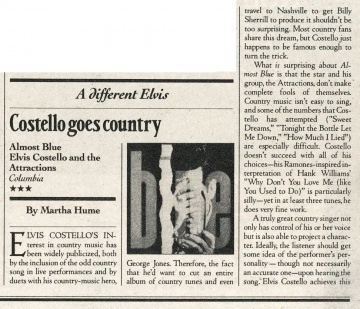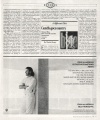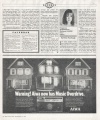Rolling Stone, December 10, 1981: Difference between revisions
(formatting) |
(formatting +image link) |
||
| (9 intermediate revisions by the same user not shown) | |||
| Line 1: | Line 1: | ||
{{Bibliography header}} | {{Bibliography header}} | ||
{{Bibliography index}} | {{:Bibliography index}} | ||
{{Rolling Stone | {{:Rolling Stone index}} | ||
{{Bibliography article header}} | {{Bibliography article header}} | ||
<center><h3> Costello goes country </h3></center> | <center><h3> Costello goes country </h3></center> | ||
<center>''' | <center>'''Elvis Costello and the Attractions ''' / Almost Blue </center> | ||
---- | ---- | ||
<center> Martha Hume </center> | <center> Martha Hume </center> | ||
---- | ---- | ||
{{Bibliography text}} | {{Bibliography text}} | ||
Elvis Costello's interest in country music has been widely publicized, both by the inclusion of the odd country song in live performances and by duets with his country-music hero, George Jones. Therefore, the fact that he'd want to cut an entire album of country tunes and even travel to Nashville to get Billy Sherrill to produce it shouldn't be too surprising. Most country fans share this dream, but Costello just happens to be famous enough to turn the trick. | |||
What is surprising about ''Almost Blue'' is that the star and his group, the Attractions, don't make complete fools of themselves. Country music isn't easy to sing, and some of the numbers that Costello has attempted ("[[Sweet Dreams]]," "[[Tonight The Bottle Let Me Down|Tonight the Bottle Let Me Down]]," "[[How Much I Lied]]") are especially difficult. Costello doesn't succeed with all of his choices — his Ramones-inspired interpretation of Hank Williams' "[[Why Don't You Love Me (Like You Used To Do)?|Why Don't You Love Me (like You Used to Do)]]" is particularly silly — yet in at least three tunes, he does very fine work. | |||
A truly great country singer not only has control of his or her voice but is also able to project a character. Ideally, the listener should get some idea of the performer's personality — though not necessarily an accurate one — upon hearing the song. Elvis Costello achieves this in Patsy Cline's "Sweet Dreams," the Flying Burrito Brothers' "[[I'm Your Toy|I'm Your Toy (Hot Burrito # 1)]]" and Jerry Chestnut's "[[Good Year For The Roses|A Good Year for the Roses]]." In each of these ballads, the vocalist is lonely, plaintive and, perhaps, resigned. There's a sense of longing here. Oddly enough, given Costello's rock & roll persona, these numbers make you want to ruffle his hair and give him a hug. | |||
In compositions that require a stronger presence, Costello doesn't fare so well. George Jones' "[[Brown To Blue|Brown to Blue]]," for example, needs high drama. The singer's in a divorce court. His tears are falling on the floor. The law is hostile and uncaring. The guy's tearing his hair out in desperation. Jones makes this scene real, while Costello sounds relatively tame. There's no feeling of being on the edge. Similarly, in Merle Haggard's "[[Tonight The Bottle Let Me Down|Tonight the Bottle Let Me Down]]" and Jones and Larry Williams' "[[Colour Of The Blues|Color of the Blues]]," the words don't fit the treatment. The problem isn't always Costello but his often questionable selection of suitable material. | |||
Obviously, Elvis Costello's strength as a country vocalist lies in his interpretation of ballads. I can hear him doing some of Willie Nelson's more reflective songs and even a Jim Reeves tune (he'd be perfect singing ''"Put your sweet lips a little closer to the phone"'' from "[[He'll Have To Go|He'll Have to Go]]"). Unfortunately, his taste seems to run to honky-tonk styles, and on these, his voice is strained and he sounds too derivative of Doug Sahm, especially in "Tonight the Bottle Let Me Down" and Charlie Rich's "[[Sittin' And Thinkin'|Sittin' and Thinkin']]." | |||
I'm sure that Costello isn't going to abandon rock & roll for the Grand Ole Opry, but his performance on ''Almost Blue'' is no joke, and the Attractions do a decent job as a country band. There is, by the way, a special bonus: ''Almost Blue'' is the first Elvis Costello album on which the listener can understand all the words. | |||
{{cx}} | {{cx}} | ||
| Line 18: | Line 26: | ||
{{Bibliography notes}} | {{Bibliography notes}} | ||
'''Rolling Stone, December 10, 1981 | {{Bibliography next | ||
|prev = Rolling Stone, November 12, 1981 | |||
|next = Rolling Stone, December 24, 1981 | |||
}} | |||
'''Rolling Stone, No. 358, December 10, 1981 | |||
---- | ---- | ||
[[Martha Hume]] reviews ''[[Almost Blue]]''. | [[Martha Hume]] reviews ''[[Almost Blue]]''. | ||
| Line 24: | Line 36: | ||
{{Bibliography images}} | {{Bibliography images}} | ||
[[image:1981-12-10 Rolling Stone page 91.jpg| | [[image:1981-12-10 Rolling Stone page 91 clipping 01.jpg|360px|border]] | ||
[[image:1981-12-10 Rolling Stone page | <br><small>Clippings.</small> | ||
[[image:1981-12-10 Rolling Stone page 94 clipping 01.jpg|360px|border]] | |||
[[image:1981-12-10 Rolling Stone cover.jpg| | [[image:1981-12-10 Rolling Stone cover.jpg|x120px|border]] | ||
<br><small>Cover.</small | [[image:1981-12-10 Rolling Stone page 91.jpg|x120px|border]] | ||
[[image:1981-12-10 Rolling Stone page 94.jpg|x120px|border]] | |||
<br><small>Cover and page scans.</small> | |||
{{Bibliography notes footer}} | {{Bibliography notes footer}} | ||
| Line 37: | Line 52: | ||
==External links== | ==External links== | ||
*[http://www.rollingstone.com RollingStone.com] | *[http://www.rollingstone.com/music/albumreviews/almost-blue-19811210 RollingStone.com] | ||
*[http://en.wikipedia.org/wiki/Rolling_Stone Wikipedia: Rolling Stone] | *[http://en.wikipedia.org/wiki/Rolling_Stone Wikipedia: Rolling Stone] | ||
{{DEFAULTSORT:Rolling Stone 1981-12-10}} | |||
[[Category:Bibliography 1981 | [[Category:Bibliography]] | ||
[[Category:Bibliography 1981]] | |||
[[Category:Rolling Stone| Rolling Stone 1981-12-10]] | [[Category:Rolling Stone| Rolling Stone 1981-12-10]] | ||
[[Category:Magazine articles | [[Category:Magazine articles]] | ||
[[Category:Album reviews | [[Category:Album reviews]] | ||
[[Category:Almost Blue reviews | [[Category:Almost Blue reviews]] | ||
Latest revision as of 07:06, 25 June 2015
|




